Synergistic effect of local endothelial shear stress and systemic hypercholesterolemia on coronary atherosclerotic plaque progression and composition in pigs
- PMID: 24148915
- PMCID: PMC4191915
- DOI: 10.1016/j.ijcard.2013.10.021
Synergistic effect of local endothelial shear stress and systemic hypercholesterolemia on coronary atherosclerotic plaque progression and composition in pigs
Abstract
Background: Systemic risk factors and local hemodynamic factors both contribute to coronary atherosclerosis, but their possibly synergistic inter-relationship remains unknown. The purpose of this natural history study was to investigate the combined in-vivo effect of varying levels of systemic hypercholesterolemia and local endothelial shear stress (ESS) on subsequent plaque progression and histological composition.
Methods: Diabetic, hyperlipidemic swine with higher systemic total cholesterol (TC) (n=4) and relatively lower TC levels (n=5) underwent three-vessel intravascular ultrasound (IVUS) at 3-5 consecutive time-points in-vivo. ESS was calculated serially using computational fluid dynamics. 3-D reconstructed coronary arteries were divided into 3mm-long segments (n=595), which were stratified according to higher vs. relatively lower TC and low (<1.2Pa) vs. higher local ESS (≥1.2Pa). Arteries were harvested at 9months, and a subset of segments (n=114) underwent histopathologic analyses.
Results: Change of plaque volume (ΔPV) by IVUS over time was most pronounced in low-ESS segments from higher-TC animals. Notably, higher-ESS segments from higher-TC animals had greater ΔPV compared to low-ESS segments from lower-TC animals (p<0.001). The time-averaged ESS in segments that resulted in significant plaque increased with increasing TC levels (slope: 0.24Pa/100mg/dl; r=0.80; p<0.01). At follow-up, low-ESS segments from higher-TC animals had the highest mRNA levels of lipoprotein receptors and inflammatory mediators and, consequently, the greatest lipid accumulation and inflammation.
Conclusions: This study redefines the principle concept that "low" ESS promotes coronary plaque growth and vulnerability by demonstrating that: (i.) the pro-atherogenic threshold of low ESS is not uniform, but cholesterol-dependent; and (ii.) the atherogenic effects of local low ESS are amplified, and the athero-protective effects of higher ESS may be outweighed, by increasing cholesterol levels. Intense hypercholesterolemia and very low ESS are synergistic in favoring rapid atheroma progression and high-risk composition.
Keywords: Coronary atherosclerosis; Endothelial shear stress; Histology; Hypercholesterolemia; Intravascular ultrasound.
© 2013.
Conflict of interest statement
Figures
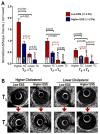
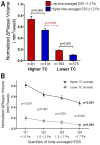
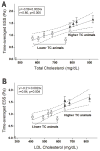
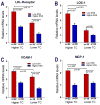
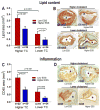
Similar articles
-
Thin-capped atheromata with reduced collagen content in pigs develop in coronary arterial regions exposed to persistently low endothelial shear stress.Arterioscler Thromb Vasc Biol. 2013 Jul;33(7):1494-504. doi: 10.1161/ATVBAHA.112.300827. Epub 2013 May 2. Arterioscler Thromb Vasc Biol. 2013. PMID: 23640495 Free PMC article.
-
Local Low Shear Stress and Endothelial Dysfunction in Patients With Nonobstructive Coronary Atherosclerosis.J Am Coll Cardiol. 2018 May 15;71(19):2092-2102. doi: 10.1016/j.jacc.2018.02.073. J Am Coll Cardiol. 2018. PMID: 29747829
-
Natural history of experimental coronary atherosclerosis and vascular remodeling in relation to endothelial shear stress: a serial, in vivo intravascular ultrasound study.Circulation. 2010 May 18;121(19):2092-101. doi: 10.1161/CIRCULATIONAHA.109.901678. Epub 2010 May 3. Circulation. 2010. PMID: 20439786 Free PMC article.
-
The role of low endothelial shear stress in the conversion of atherosclerotic lesions from stable to unstable plaque.Curr Opin Cardiol. 2009 Nov;24(6):580-90. doi: 10.1097/HCO.0b013e328331630b. Curr Opin Cardiol. 2009. PMID: 19809311 Free PMC article. Review.
-
Role of endothelial shear stress in the natural history of coronary atherosclerosis and vascular remodeling: molecular, cellular, and vascular behavior.J Am Coll Cardiol. 2007 Jun 26;49(25):2379-93. doi: 10.1016/j.jacc.2007.02.059. Epub 2007 Jun 8. J Am Coll Cardiol. 2007. PMID: 17599600 Review.
Cited by
-
Inflammation and enhanced atherogenesis in the carotid artery with altered blood flow in an atherosclerosis-resistant mouse strain.Physiol Rep. 2021 Jun;9(11):e14829. doi: 10.14814/phy2.14829. Physiol Rep. 2021. PMID: 34110700 Free PMC article.
-
Effects of Postprandial Lipemia Combined With Disturbed Blood Flow on the Flow-Mediated Dilation, Oxidative Stress, and Endothelial Microvesicles in Healthy Subjects.Front Physiol. 2022 Feb 24;13:812942. doi: 10.3389/fphys.2022.812942. eCollection 2022. Front Physiol. 2022. PMID: 35283771 Free PMC article.
-
12/15-lipoxygenase mediates disturbed flow-induced endothelial dysfunction and atherosclerosis.Mol Med. 2025 Jul 15;31(1):257. doi: 10.1186/s10020-025-01297-0. Mol Med. 2025. PMID: 40660143 Free PMC article.
-
Variation in Coronary Atherosclerosis Severity Related to a Distinct LDL (Low-Density Lipoprotein) Profile: Findings From a Familial Hypercholesterolemia Pig Model.Arterioscler Thromb Vasc Biol. 2019 Nov;39(11):2338-2352. doi: 10.1161/ATVBAHA.119.313246. Epub 2019 Sep 26. Arterioscler Thromb Vasc Biol. 2019. PMID: 31554418 Free PMC article.
-
Comprehensive plaque assessment by coronary CT angiography.Nat Rev Cardiol. 2014 Jul;11(7):390-402. doi: 10.1038/nrcardio.2014.60. Epub 2014 Apr 22. Nat Rev Cardiol. 2014. PMID: 24755916 Review.
References
-
- Nicholls SJ, Tuzcu EM, Crowe T, et al. Relationship between cardiovascular risk factors and atherosclerotic disease burden measured by intravascular ultrasound. J Am Coll Cardiol. 2006;47:1967–75. - PubMed
-
- Libby P, Theroux P. Pathophysiology of coronary artery disease. Circulation. 2005;111:3481–8. - PubMed
-
- Chatzizisis YS, Coskun AU, Jonas M, et al. Role of endothelial shear stress in the natural history of coronary atherosclerosis and vascular remodeling: molecular, cellular and vascular behavior. J Am Coll Cardiol. 2007;49:2379–93. - PubMed
-
- Stone PH, Saito S, Takahashi S, et al. Prediction of progression of coronary artery disease and clinical outcomes using vascular profiling of endothelial shear stress and arterial plaque characteristics: the PREDICTION Study. Circulation. 2012;126:172–81. - PubMed
-
- Wentzel JJ, Chatzizisis YS, Gijsen FJ, et al. Endothelial shear stress in the evolution of coronary atherosclerotic plaque and vascular remodeling: current understanding and remaining questions. Cardiovsc Res. 2012;96:234–43. - PubMed
Publication types
MeSH terms
Grants and funding
LinkOut - more resources
Full Text Sources
Other Literature Sources
Medical

